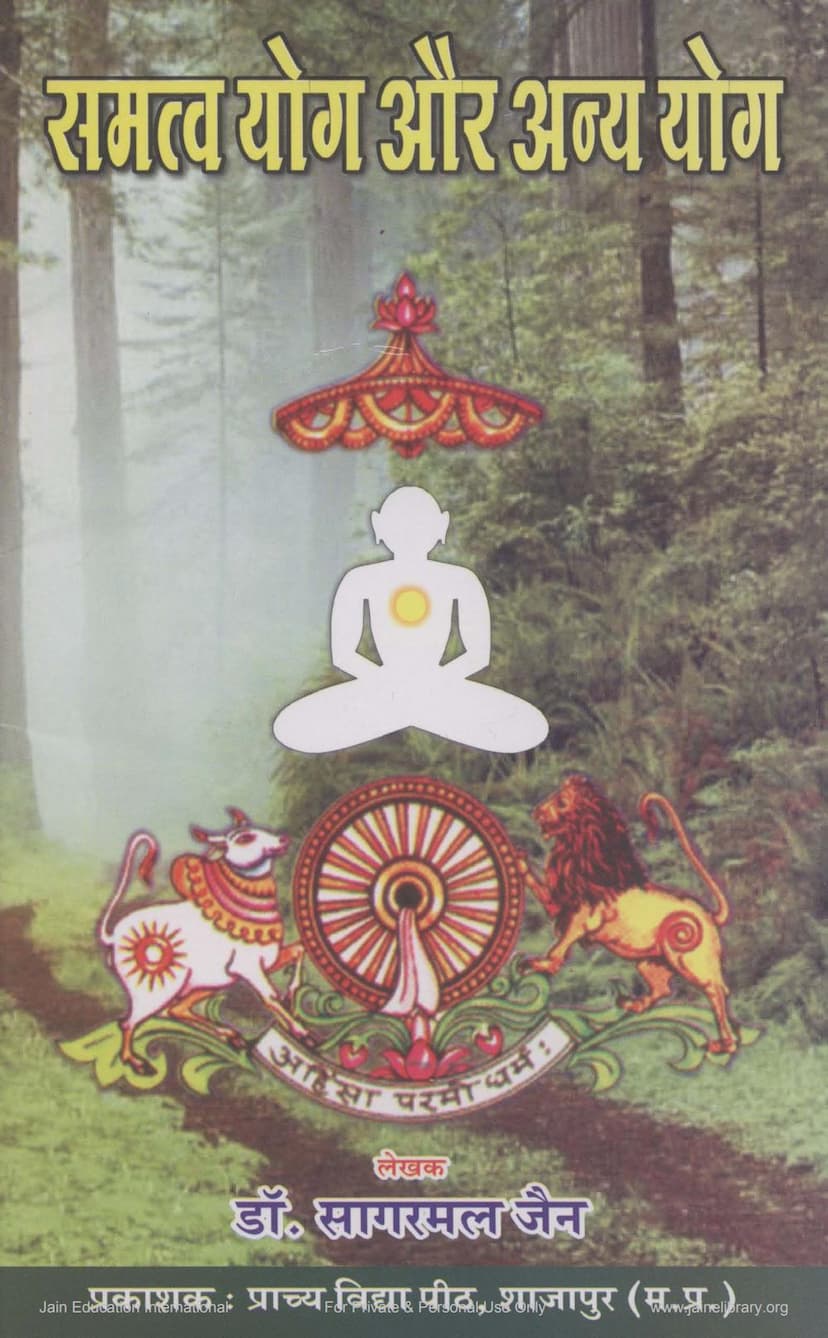Samatva Yoga Aur Anya Yoga
Added to library: September 2, 2025

Summary
Here's a comprehensive summary of the Jain text "Samatva Yoga aur Anya Yoga" by Sagarmal Jain, focusing on the core concepts and arguments presented:
Book Title: Samatva Yoga aur Anya Yoga (Samatva Yoga and Other Yogas) Author: Sagarmal Jain Publisher: Prachya Vidyapith Shajapur
This book explores the central concept of Samatva Yoga (Yoga of Equanimity) within Jainism and compares it to similar concepts in Buddhist and Bhagavad Gita philosophies. The author argues that Samatva Yoga is the core essence of Jain ethics and spiritual practice, aiming for a state of equanimity and detachment.
Core Argument and Concepts:
- Samatva Yoga as the Central Tenet of Jain Sadhana: The book posits that the pursuit of Samatva (equanimity, impartiality, sameness) is the fundamental principle of Jain ethical and spiritual life. All Jain injunctions and prohibitions are ultimately aimed at achieving this state.
- The Nature of Dis-equilibrium (Vishmata): The text explains that the natural state of consciousness is to maintain equilibrium. However, due to attachment (mamata) and ignorance (avidya), consciousness deviates from its natural equilibrium. This deviation leads to the identification with external objects (body, family, worldly possessions), resulting in attraction (raga) and aversion (dvesha). These dualistic emotions create internal conflict and suffering.
- Psychological Conflict: The text draws parallels with Freudian concepts, mentioning the internal conflict between the ideal and the instinctual aspects of consciousness. This leads to a scattering of mental energy.
- The Role of Attachment (Raga/Asakti): Attachment to external objects and experiences is identified as the root cause of suffering. This attachment leads to desires, cravings, and anxieties, disrupting inner peace.
- Samatva Yoga as the Solution: Samatva Yoga is presented as the path to overcome this dis-equilibrium and internal conflict. It involves rising above attachment and aversion to achieve a state of inner balance and stability.
- Samatva Yoga in Jain Philosophy:
- Samayika: The Jain term for this practice is Samayika, derived from the Sanskrit root "sam" (meaning equanimity, equality, and detachment from raga-dvesha) and "aya" (meaning to go, to know, or to attain). Thus, Samayika signifies the attainment of a state free from raga-dvesha, encompassing right faith (Samyakdarshan), right knowledge (Samyakjnana), and right conduct (Samyakcharitra).
- Threefold Path: Jain practice is characterized by the "Triple Jewel" – right faith, right knowledge, and right conduct – which are understood as different facets of achieving Samatva.
- Causes of Vishmata in Jainism: Moha (delusion) and the resulting attachment (asakti) are identified as the primary causes for the soul deviating from its true center of equilibrium. This ignorance covers the inherent equanimity of the soul, and the subsequent passions (kleshas) are directed towards external objects.
- The Importance of Samatva Yoga in Jainism: The text emphasizes the supreme importance of Samatva Yoga in Jainism, stating that anyone who lives in Samabhava (equanimity), regardless of their sect or practices, will attain liberation. It is presented as a more potent means of spiritual progress than mere external austerities or rituals.
- Samatva Yoga in Buddhist Philosophy: The book draws parallels with Buddhist philosophy, particularly the concept of Samma (right or proper) in the Noble Eightfold Path. The Buddhist ideal of Samyak Samadhi (right concentration) is seen as a state of mental equanimity and freedom from raga-dvesha, akin to Jain Samayika. The Buddhist emphasis on detachment and understanding the impermanent nature of reality aligns with the Jain pursuit of equanimity.
- Samatva Yoga in the Bhagavad Gita: The author extensively discusses the Bhagavad Gita's teachings on Samatva Yoga. The Gita defines Yoga as Samatvam Yoga Uchyate (equanimity is called Yoga) and Yogah Karmasu Kaushalam (Yoga is skill in action). The text explains that the Gita advocates for achieving equanimity in dualities like pleasure and pain, gain and loss, victory and defeat. This equanimity is seen as the ultimate goal (sadhyam) of various paths like Jnana Yoga (path of knowledge), Karma Yoga (path of action), and Bhakti Yoga (path of devotion). The Gita suggests that these paths are means to achieve the ultimate state of Samatva.
- Practical Aspects of Samatva Yoga:
- Overcoming Conflict: Samatva Yoga is presented as a way to transcend internal conflicts arising from desires and external conflicts with the environment.
- Key Principles: The text highlights key principles for practicing Samatva Yoga:
- Anasakti (Non-attachment): The foundation of equanimity lies in non-attachment to possessions, people, and outcomes. This includes overcoming ego (aham) and possessiveness (mamata).
- Anagraha (Non-dogmatism/Non-clinging to views): In the realm of thought, it means being open to multiple perspectives (anekanta) and avoiding rigid adherence to one's own views.
- Ahimsa (Non-violence): The practice of non-violence, rooted in the understanding of the equality of all beings (atmavat-drishti), is crucial for social harmony.
- Asangraha (Non-possession/Non-accumulation): This practical principle supports non-attachment and contributes to social equality by reducing economic disparities.
- Jain Yoga in Historical Context: The book traces the development of Jain yoga practices, highlighting influences and parallels with other Indian traditions, particularly Patanjali's Yoga Sutras. It discusses the evolution of Jain yoga through different periods, noting the integration of concepts like meditation, postures, breath control, and sensory restraint. It also acknowledges the impact of Tantric and ritualistic practices in later periods and the subsequent revival of spiritual yoga.
Conclusion:
The book strongly advocates for Samatva Yoga as the ultimate goal of spiritual life, transcending all dualities and conflicts. It is presented as the unifying principle that underpins the ethical and spiritual practices of Jainism, and it finds resonance with similar ideals in Buddhism and the Bhagavad Gita. The author emphasizes that by cultivating non-attachment, non-dogmatism, non-violence, and non-possession, one can achieve true inner balance and contribute to social harmony.